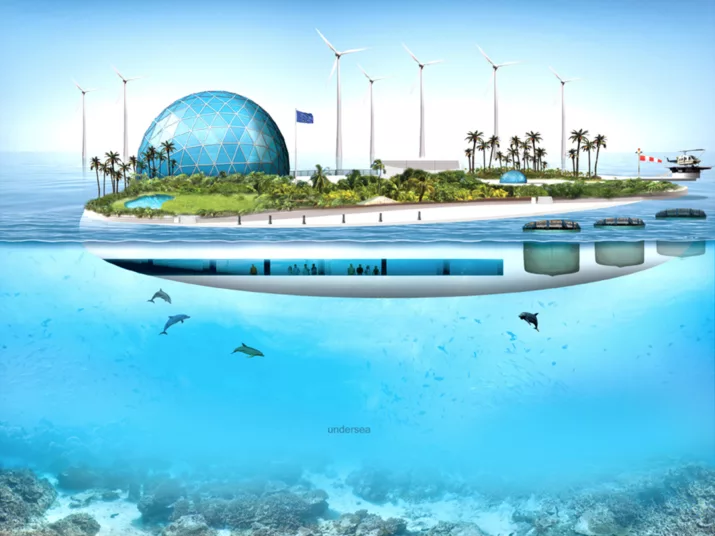
Thinking Space Nature
Notes from an Offshore Island
Imagine if there were islands in the middle of the sea, where alongside the palm trees stood wind turbines towering into the sky? There, where the giants of the ocean, like whales and container ships, wend their way. Where the water is miles deep – and the coast is miles away. A journey of the mind into the (possible) future.
Summer of 2050. Day 3 on the open sea. The destination of our voyage: an artificial island world, far out at sea. Like a green oasis, it suddenly appears on the horizon. Not a mirage in the watery desert, but an important power supplier for the distant coastal region. White wind turbines flash in the sun. At least a dozen of them show us the way.
What we can only guess at from a distance becomes a certainty on arrival: island-hopping is, in our case, actually platform-hopping. We can choose between three artificial islands. The sign “Fuel and Check-up” sends us to island number one.
We drop anchor. Our plan is to become offshore islanders for the night to recover from our sailor’s diet and the rocking waves. Hard to believe, but our – well-moored! – holiday island is floating. However, we don’t notice it at all. And it’s amazingly green, with a grove of date palms right next to the harbour!
Hydrogen in the ship’s tank
Our skipper refuels our ship for the continuation of our journey. Of course, it runs on green electricity – just like all the other boats waiting to be refuelled in the harbour basin. We are under way with hydrogen as fuel, which is produced directly on site from wind energy and water. There’s more than enough of both here.
A cargo ship is docked next to us. Technicians from the nearby dockyard board the ship. While they check it over, a robot takes some of the cargo directly to the nearby warehouse. The other containers will continue their journey to the mainland on one of the many ships that stop here.
Fruit and vegetables under the solar dome
With a tank full of gas, we’re on our way again. Off to the second ocean platform! Ten minutes later, we dock. We’ve booked a tour of the island, because we’re curious. A car is already waiting for us at the harbour building. Its doors open automatically. We get in. Our virtual guide welcomes us via monitor.
Are we fazed by the fact that the car is driverless and has solar panels on its roof? Not in the least. We roar through wind farms, past huge domes of solar collectors. So this is where they grow all the fruit and vegetables that we’ll later find on our plates in the hotel restaurant.
If you want, you can also try fresh fish that’s been bred on the island, says our guide: offshore cod. At the island fishery, we learn all there is to know about fish farming on the high seas. Through the glass floor in the fishery building, we stare down at the glittering swarms in the cages swaying in the sea below the floating island.
On the cage bars we discover mussels and seaweed. They’ll also end up on the plate, the workers explain to us. What’s not served in the island restaurant is transported to the mainland. Or it’s used as yet another natural energy source on the offshore islands: smaller algae are transformed into clean fuel at the nearby biogas plant.
Trip to the fish swarms
The blood-red sun dips down into the smooth sea. Even after being at sea for days, it’s still a sight that fills us all with awe. Now we’re off to the third and last island of the artificial archipelago. As we set course for Leisure Island, the seagulls hover overhead in the fading light. Below us the ocean, the colour of anthracite. Somewhere deep on the seabed are the offshore island’s spherical storage tanks, just as our virtual guide explained.
Can we dive down to them? Too deep. However, according to the guide, “Leisure Island” offers an excursion to the fish swarms. And indeed: right next to our island hotel, which is located directly at the harbour, there’s a diving station. We want to know from the hotel manager what else the island has to offer. Golfing, shopping, bathing in the artificial lake. Actually, everything here is at our fingertips. And is swimming. In the middle of the ocean. We’ll definitely visit again.
Read more
Bergström, L. et al. (2014): Effects of offshore wind farms on marine wildlife — a generalized impact assessment. Environmental Research Letters, 9(3), 034012 [1]
https://windeurope.org/wp-content/uploads/files/about-wind/reports/Floating-offshore-statement.pdf
WBGU (2013): Welt im Wandel: Menschheitserbe Meer. Berlin: Wissenschaftlicher Beirat der Bundesregierung Globale Umweltveränderungen (WBGU) [2]
About the Tropos research project: http://www.troposplatform.eu/